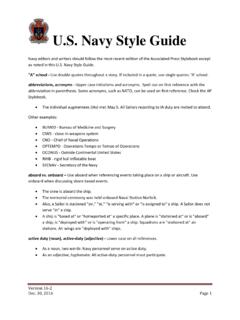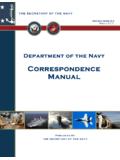Transcription of BUPERSINST 1610 - Navy FITREP
1 BUPERSINST PERS-32 1 May 2015 BUPERS INSTRUCTION From: Chief of Naval Personnel Subj: navy PERFORMANCE EVALUATION SYSTEM Ref: (a) OPNAVINST (b) NAVPERS 15560D, Naval Military Personnel Manual (MILPERSMAN) (c) BUPERSINST (d) SECNAVINST (e) OPNAVINST (f) OPNAVINST (g) BUPERSINST Encl: (1) navy Performance Evaluation System Overview for Commanding Officers, Delegated Reporting Seniors, and Raters (2) navy Performance Evaluation System Manual (EVALMAN) 1. Purpose. To publish revised guidance for performance evaluation and to publish the revised navy Performance Evaluation Manual (EVALMAN). 2. Cancellation. BUPERSINST 3. Information. This revision provides updated administrative and policy changes affecting navy 's performance evaluation system. Enclosure (1) provides an overview of the system for commanding officers (COs), reporting seniors, and raters.
2 The EVALMAN provides requirements for completion and submission of the report forms. Organization of the EVALMAN and a brief summary of the chapters are provided in the introduction section of enclosure (2). 4. Significant Changes. Wherever possible, existing fitness report and counseling record ( FITREP ) and evaluation report and counseling record (CHIEFEVAL and EVAL) policies have been kept in effect. The most important changes to this instruction include: BUPERSINST 1 May 2015 2 a. Incorporating NAVADMIN 183/11 that realigns the strategic sealift officer (SSO) designators within the 16xx series. The new designator is now special duty - strategic sealift (166X). b. Incorporating NAVADMIN 219/11 that establishes a 60 percent Early and Must Promote combined promotion recommendation limit for lieutenants. c. Incorporating NAVADMIN 028/13 that requires using combined officer summary groups for Information Dominance Corps (IDC) officers, regardless of designator.
3 D. Incorporating NAVADMIN 243/14 which directs that Transition Assistance Program Military Life Cycle counseling requirements are met. e. Incorporating BUPERSINST change 1 that reinforces the importance of evaluating commanders, officers, and Sailors on their contributions to command or organizational climate/equal opportunity and military bearing/character. f. Requiring reporting seniors to document whether commanders, commanding officers, and officers-in-charge conduct required command climate assessments. g. Incorporating BUPERSINST change 2 that updates guidance for evaluating performance in the area of Military Bearing for flag officers. h. Prohibiting comments in block 41/43 (Comments on Performance) regarding a member s potential for civilian employment. i. Incorporating Reserve-specific language where applicable throughout the instruction to clarify procedures and enhancing Active Duty reports on Reservists providing operational support.
4 J. Incorporates comments on evaluating unit commanders and commanding officers on a command s personnel security program and comments on officers and senior enlisted. BUPERSINST 1 May 2015 3 k. Incorporates comments on evaluating senior enlisted and officers on their contributions to building an innovative culture. 5. Change Recommendations. FITREP , chief petty officer evaluations (CHIEFEVAL), and EVAL policies, procedures, and requirements may be modified only by change to this instruction. Submit recommendations to navy Personnel Command (NAVPERSCOM), Performance Evaluations Division (PERS-32). 6. Records Management. Records created as a result of this instruction, regardless of media and format, shall be managed per Secretary of the navy Manual of January 2012. 7. Forms a. OPNAV 5239/14 System Authorization Access Request- navy is available at b.
5 The following forms may be obtained at (1) NAVPERS 1610/5 Fitness Report and Counseling Record (O7-O8). (2) NAVPERS 1610/2 Fitness Report and Counseling Record (W2-O6). (3) NAVPERS 1616/27 Evaluation and Counseling Record (E7 E9). (4) NAVPERS 1616/26 Evaluation Report and Counseling Record (E1-E6). c. NAVPERS 1616/23 MEMORANDUM Signature Authentication to Accept Non CAC user fitreps is available through the Office of the Chief of Naval Operations (OPNAV), Flag Matters (N00F) at (703) 604-5750/DSN 224. BUPERSINST 1 May 2015 4 8. Reports. Report Control Symbol BUPERS 1610-1 has been assigned to the reports required by paragraph 3 and is approved per Secretary of the navy Manual of December 2005. W. F. MORAN Vice Admiral, navy Distribution: Electronic only via BUPERS Web site BUPERSINST 1 May 2015 navy PERFORMANCE EVALUATION SYSTEM OVERVIEW FOR COMMANDING OFFICERS, DELEGATED REPORTING SENIORS, AND RATERS BUPERSINST 1 May 2015 1 Enclosure (1) 1.
6 Purpose. This enclosure provides an overview of the navy Performance Evaluation System. This is a Total Force instruction and is applicable to all Active Duty (ACDU), Full Time Support (FTS), and Inactive (INACT) duty Reserve personnel. While each of the statements in this enclosure constitutes policy, specific actions may require the detailed instructions found in the EVALMAN, enclosure (2). 2. How Does the Report Work? The system utilizes a FITREP for officers (W2-O6), CHIEFEVAL for chief petty officers (CPO) (E7-E9) and an EVAL for other enlisted personnel (E1-E6). Performance traits are graded on a 5-point scale, from (lowest) to (highest), using performance standards printed on the forms. The performance trait grade of represents performance to full navy standards. Higher grades are reserved for performance which significantly exceeds standards. All grades must be substantiated in the comments, as well as general comments on the remainder of the evaluative blocks.
7 If there is a promotion recommendation of "Significant Problems," or any recommendation against retention, the report shall be treated as adverse. All forms provide a 5-step promotion recommendation scale: "Significant Problems," "Progressing," "Promotable," "Must Promote," and "Early Promote." "Early Promote" recommendations are based solely on performance, and do not require eligibility for early promotion. There are, however, mandatory limits on the number of "Early Promote" recommendations. For pay grades O1 and O2 (with the exception of limited duty officers (LDOs)), no promotion recommendation higher than Promotable is allowed. For the more senior officer and enlisted pay grades, there are also limits on "Must Promote" recommendations. These limits ensure a sufficient range of recommendations that make the reports useful to the promotion system. For enlisted personnel, the promotion recommendation is also the performance mark average for the report period.
8 The recommendations are translated into marks of , , , , and , respectively, on the traditional grading scale. Refer to Chapter 16 section 16-3 for guidance. 3. Who Can Be a Reporting Senior? a. COs and officers in charge (OICs) are reporting seniors by virtue of their command authority. They may submit properly authorized fitreps , CHIEFEVALs, and EVALs on any member who has reported to them for duty, whether junior or senior to them in grade. The term "commanding officer" is inclusive of all BUPERSINST 1 May 2015 Enclosure (1) 2 Services and their civilian equivalents within the Federal Government. OICs are reporting seniors if they are in charge of commissioned or established activities listed in the Standard navy Distribution List. When a member is assigned to a Government activity, the reporting senior is the member's administrative commander unless another reporting senior is assigned by order or directive.
9 A member in this category may receive a letter-type report from the Government activity for attachment to a FITREP , CHIEFEVAL, or EVAL. b. Delegation of reporting senior authority is an actual transfer of that authority, and not merely an authorization to sign "By direction." For this reason, delegation is held to the highest level consistent with effective observation of performance, and the CO s oversight responsibilities are carefully defined. For specific direction concerning delegated reporting seniors, refer to enclosure (2), chapter 2. c. An immediate superior in command (ISIC) is a reporting senior for assigned COs and is authorized to assume the reporting senior authority of a subordinate CO whose capacity to act as a reporting senior becomes impaired. Specific guidance is contained in enclosure (2), chapter 2. d. An enlisted OIC in the grade of E9 and civilians in command positions who hold the grade of GS-9 through GS-12 may sign reports on E5 and below.
10 A chief petty officer (CPO) or senior chief petty officer (SCPO) may sign reports on personnel E4 and below only. GS-13 or equivalent may sign reports for E1 to E9. Reporting senior authority for enlisted OICs in the grade of E7 and E8 may be delegated to sign E5 reports with the prior written approval of NAVPERSCOM (PERS-32). All other reports will be signed by a senior in the chain of command having authority to report on the member concerned. 4. Who are the Raters and Senior Raters? What Do They Do? EVALs on personnel E6 and below should contain the signatures of a rater and senior rater. The signature of the reporting senior is required. This ensures that navy 's senior enlisted and junior officer supervisors are properly included in the enlisted EVAL process. a. The rater for personnel E1-E4 can be an E6 or civilian equivalent (GS-5). For personnel E5-E6, the rater should be a BUPERSINST 1 May 2015 3 Enclosure (1) navy CPO whenever possible, but if none is available within the command, the rater may be a military or civilian supervisor who is an E7 equivalent (GS-6) or higher.







